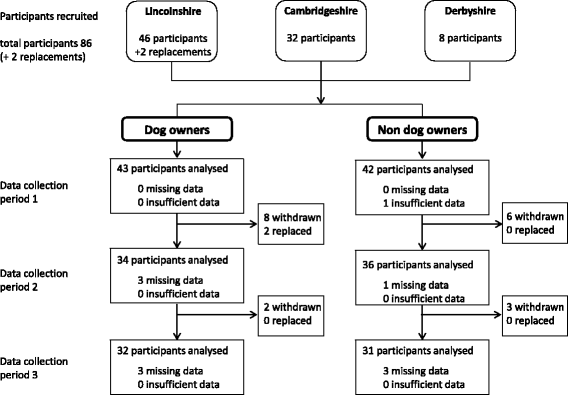The influence of dog ownership on objective measures of free-living physical activity and sedentary behaviour in community-dwelling older adults: a longitudinal case-controlled study
- PMID: 28595596
- PMCID: PMC5465590
- DOI: 10.1186/s12889-017-4422-5
The influence of dog ownership on objective measures of free-living physical activity and sedentary behaviour in community-dwelling older adults: a longitudinal case-controlled study
Abstract
Background: There is some evidence to suggest that dog ownership may improve physical activity (PA) among older adults, but to date, studies examining this, have either depended on self-report or incomplete datasets due to the type of activity monitor used to record physical activity. Additionally, the effect of dog ownership on sedentary behaviour (SB) has not been explored. The aim of the current study was to address these issues by using activPAL monitors to evaluate the influence of dog ownership on health enhancing PA and SB in a longitudinal study of independently-mobile, community-dwelling older adults.
Methods: Study participants (43 pairs of dog owners and non-dog owners, matched on a range of demographic variables) wore an activPAL monitor continuously for three, one-week data collection periods over the course of a year. Participants also reported information about their own and their dog demographics, caring responsibilities, and completed a diary of wake times. Diary data was used to isolate waking times, and outcome measures of time spent walking, time spent walking at a moderate cadence (>100 steps/min), time spent standing, time spent sitting, number of sitting events (continuous periods of sitting), and the number of and of time spent sitting in prolonged events (>30 min). For each measure, a linear mixed effects model with dog ownership as a fixed effect, and a random effects structure of measurement point nested in participant nested in pair was used to assess the effect of dog ownership.
Results: Owning a dog indicated a large, potentially health improving, average effect of 22 min additional time spent walking, 95%CI (12, 34), and 2760 additional steps per day, 95%CI (1667, 3991), with this additional walking undertaken at a moderate intensity cadence. Dog owners had significantly fewer sitting events. However, there were no significant differences between the groups for either the total time spent sitting, or the number or duration of prolonged sedentary events.
Conclusions: The scale of the influence of dog ownership on PA found in this study, indicates that future research regarding PA in older adults should assess and report dog ownership and/or dog walking status.
Keywords: ActivPAL; Dog walking; Elderly; Exercise; Human-animal interaction; Pet ownership; Physical behaviour; Sitting.
Figures
References
MeSH terms
LinkOut - more resources
Full Text Sources
Other Literature Sources
Medical


